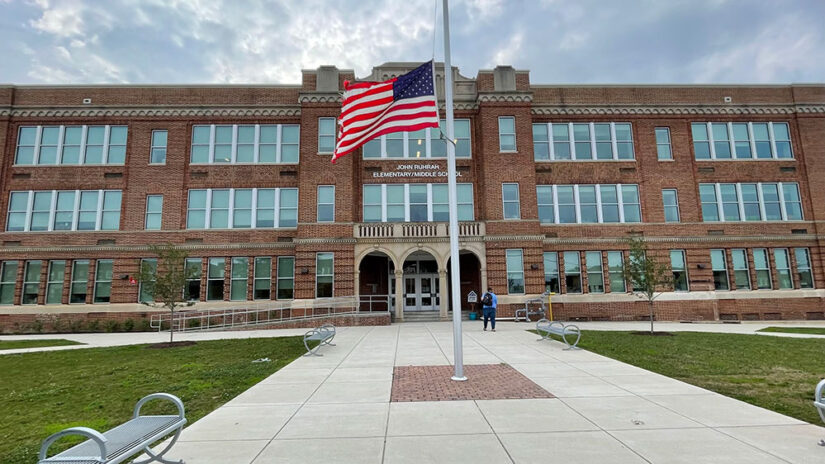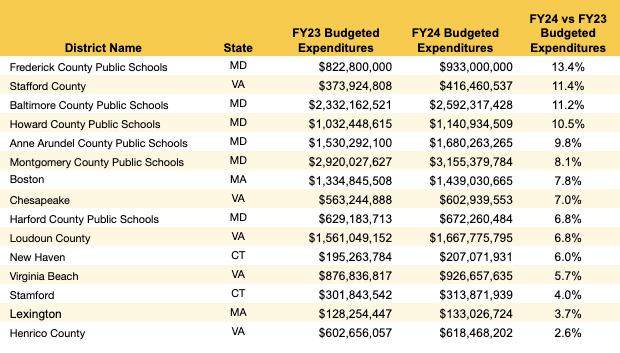Maryland Schools to Receive Added $600M as Blueprint Funds Flow to Districts
The state’s decade-long plan to boost academic achievement and equity will deliver more than $7.5 billion to schools in 2024.

Get stories like this delivered straight to your inbox. Sign up for The 74 Newsletter
Maryland education officials proposed steep spending increases in their school budgets next year, an indicator that implementation of the state’s heralded “Blueprint” policy for school transformation is moving forward.
Howard, Baltimore and Frederick counties proposed double-digit hikes — above 2023 levels by 10.5%, 11.2% and 13.4%, respectively — according to an analysis by the school data service Burbio.
Much of the funding for the additional spending is coming from the state, which will send over $7.5 billion to local districts in 2024 thanks to the Blueprint law, an increase of more than $600 million above 2022-23 levels, according to preliminary budget figures provided to The 74 by the State Department of Education. Some 21 of the state’s 23 school districts will receive more funds than they did this year.
Prince George’s County is set to get the largest bump with an extra $195 million from the state for next year, the data show. The smaller Caroline County will receive the greatest new windfall proportional to its student body with $1,680 added for each of its 5,600 students. Allegany County and Baltimore City are the only districts that will see a slight drop in funds compared to this year.

William Kirwan, who chaired the commission that drafted the legislation for the 2021 Blueprint policy, said the new budget plans are “absolutely” a marker of schools’ progress toward complying with the landmark law’s provisions.
The 10-year Blueprint plan is in its third year of implementation. Ultimately, it will inject an additional $3.8 billion annually into the state’s education system, some $4,000 extra per student. In return for the funds, the law compels districts to work toward improvement measures such as universal preschool, $60,000 minimum annual teacher salaries by 2026 and widened access to college and career-preparation courses for high schoolers.
“No state has ever undertaken anything like this,” Kirwan said. He describes the changes as a “total overhaul.”
School budgets have been swelling nationwide thanks to the federal COVID stimulus package delivering $190 billion for K-12 education in one-time funds. But the preliminary figures from Burbio show that growth is continuing at a faster rate in several Maryland districts than in comparable school systems in other states. And unlike pandemic stimulus cash, Blueprint funds represent a longer-lasting source of revenue.
Burbio’s report includes the projected budgets of large districts in four states: Virginia, Massachusetts, Connecticut and Maryland. The Maryland districts accounted for five of the top six largest proposed spending increases out of the 15 included.

The Howard County Public School System said it plans to use Blueprint funds to recruit, retain and train educators, including a grow-your-own initiative to help paraprofessionals become lead teachers. It also is devoting money to pay the tuition of high school students who take dual enrollment courses at a local community college, among other efforts.
In Baltimore County, the funds will help the school district raise teachers’ minimum starting salary to $59,000 next year and cover the costs of AP tests for all students enrolled in those advanced classes, among other measures, spokesperson Charles Herndon said.
Each year, Blueprint funds will provide roughly 500 Maryland students pursuing a teaching degree with a full scholarship for tuition, Kirwan added.
Existing teacher shortages “will be short-lived in Maryland when word gets out,” he predicts.
The Blueprint’s formula adjusts funding levels using a measure for concentration of poverty, and delivers the most total funding per pupil to Somerset County and Baltimore City schools, the two districts in the state serving the highest share of students eligible for free- or reduced-price lunch. Baltimore City’s slight drop in funding in 2024 is because it will go from receiving the highest per-pupil allocation to the second-highest.
Meanwhile, as funding flows to schools and as officials move to launch new initiatives, districts have until March 15 to submit formalized implementation plans to a newly created board overseeing the Blueprint’s rollout.
The decade-long policy is scheduled to be fully implemented by 2033.
“It’s a long process,” Kirwan said.
Get stories like these delivered straight to your inbox. Sign up for The 74 Newsletter

;)
